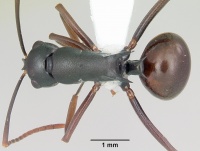Polyrhachis arborea
| Polyrhachis arborea | |
|---|---|

| |
| Scientific classification | |
| Kingdom: | Animalia |
| Phylum: | Arthropoda |
| Class: | Insecta |
| Order: | Hymenoptera |
| Family: | Formicidae |
| Subfamily: | Formicinae |
| Tribe: | Camponotini |
| Genus: | Polyrhachis |
| Subgenus: | Myrmhopla |
| Species: | P. arborea |
| Binomial name | |
| Polyrhachis arborea Kohout, 2008 | |
Nothing is known about the biology of Polyrhachis arborea.
Identification
A member of the Polyrhachis mucronata species group.
Kohout (2008) - The body sculpturation of P. arborea is rather variable. In most specimens of type series it consists of small punctures that are superimposed over larger, very shallow depressions. However, in the specimens from Lore Lindu the sculpturation is simply reticulate-punctate. Polyrhachis arborea resembles Polyrhachis moesta and Polyrhachis orpheus. It differs from both in having considerably longer and more slender antennal scapes. The propodeal spines are also longer and virtually horizontal in P. arborea, while they are oblique in profile in the other two species.
Keys including this Species
Distribution
Distribution based on Regional Taxon Lists
Indo-Australian Region: Indonesia (type locality), Sulawesi.
Distribution based on AntMaps
Distribution based on AntWeb specimens
Check data from AntWeb
Countries Occupied
| Number of countries occupied by this species based on AntWiki Regional Taxon Lists. In general, fewer countries occupied indicates a narrower range, while more countries indicates a more widespread species. |

|
Estimated Abundance
| Relative abundance based on number of AntMaps records per species (this species within the purple bar). Fewer records (to the left) indicates a less abundant/encountered species while more records (to the right) indicates more abundant/encountered species. |

|
Biology
Castes
Worker
Images from AntWeb
   
| |
| Worker. Specimen code casent0103189. Photographer April Nobile, uploaded by California Academy of Sciences. | Owned by QM, Queensland, Australia. |
Nomenclature
The following information is derived from Barry Bolton's Online Catalogue of the Ants of the World.
- arborea. Polyrhachis arborea Kohout, 2008a: 303, figs. 10C-D (w.) INDONESIA (Sulawesi).
Unless otherwise noted the text for the remainder of this section is reported from the publication that includes the original description.
Description
Worker
(holotype cited first): TL c. 6.25, 5.90-6.70; HL 1.59, 1.47-1.68; HW 1.22, 1.12-1.25; CI 77, 73-77; SL 2.09, 1.96-2.18; SI 171, 171-182; PW 0.87, 0.84-0.97; MTL 2.25, 2.09-2.34 (17 measured).
Anterior clypeal margin with median truncation, flanked by distinct, blunt denticles. Clypeus with blunt median carina that is weakly elevated posteriorly; clypeus in profile straight, rounding posteriorly into moderately impressed basal margin, laterally basal margin consisting of a thin, sculpture-breaking line. Frontal triangle distinct. Frontal carinae sinuate with distinctly raised margins; central area concave with rather short frontal furrow. Sides of head in front of eyes converging towards mandibular bases in weakly convex line; behind eyes sides rounding into relatively narrow, convex occipital margin. Eyes convex, in full face view clearly breaking lateral cephalic outline. Ocelli lacking. Pronotal humeri produced into blunt angles, rather indistinctly in some specimens. Mesosoma in profile with pronotal dorsum weakly convex; promesosonal suture distinct; mesonotal dorsum flat. Metanotal groove a distinct, posteriorly bowed line. Propodeal dorsum very short, with lateral margins terminating in broad-based, horizontal, weakly laterally and posteriorly directed spines; inner margins of spines curving onto propodeal dorsum, forming weakly open ‘U’ in dorsal view; declivity relatively high, oblique in profile. Petiole with pair of widely diverging, relatively short spines; petiolar dorsum rounded in profile, spines arising from below summit. Anterior face of first gastral segment widely rounding onto dorsum.
Mandibles finely, longitudinally striate, with numerous piliferous pits. Head shallowly reticulate-punctate, more distinctly on vertex. Mesosoma sculpturation ranging from very dense punctatation overlying larger, rather shallow depressions in some specimens to simply reticulate-punctate in others; general appearance ranging from opaque to moderately smooth and polished. Gaster finely shagreened.
Mandibular masticatory borders with several curved, golden hairs and numerous short, closely appressed hairs towards bases. Anterior clypeal margin with a few longer setae medially and a pair of rather short hairs arising laterally behing margin. Anterior face of fore coxae with one or two longer, erect hairs. Gaster with several medium length, erect hairs along dorsoapical margins segments; hairs more numerous and distinctly longer on gastral venter. Closely appressed, very short, golden pubescence arising from numerous pits over all body surfaces.
Colour. Head, mesosoma, petiole and mid and hind coxae black. Mandibles, clypeus and front of head blotched with diffuse reddish-brown. Antennae, legs and gaster medium reddish-brown with tarsi distinctly darker. Narrow band across bases of mandibular teeth, condylae, funicular segments towards apex and apical segment of tarsi, light yellowish-brown.
Type Material
HOLOTYPE: SULAWESI TENGAH: nr Morowali, Ranu R. area, 27.i.-20.iv.1980, M.J.D. Brendell, B.M. 1980-280 (worker). PARATYPES: data as for holotype (14 workers). SULAWESI UTARA: Dumoga-Bone NP, 9.-16.v. 1985 (N.E. Stork et al.) (worker); ditto, 230m, 2.xii.1985, fog., N.E. Stork et al. (worker). Holotype and (8) paratypes in The Natural History Museum; 2 paratypes each in Australian National Insect Collection, Museum of Comparative Zoology and Queensland Museum.
References
References based on Global Ant Biodiversity Informatics
- Kohout, R. J. 2008. A review of the Polyrhachis ants of Sulawesi with keys and descriptions of new species (Hymenoptera: Formicidae: Formicinae). Memoirs of the Queensland Museum 52:255-317.

